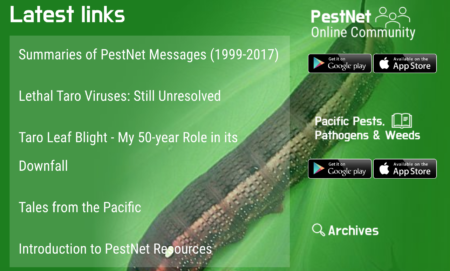- How people used cereals before agriculture in the Fertile Crescent (roughly speaking).
- Fast forward two thousand years and meet Elba, the shepherdess of Courel. And some aurochs.
- Nine thousand years later, MusaNet revamps its website…
- …and coconut revamps its conservation strategy.
- And finally, here are some post-agricultural tomatoes.
PestNet launches new website
PestNet is a network that helps people worldwide obtain rapid advice and information on crop protection, including the identification and management of plant pests. It started in 1999. Anyone with an interest in plant protection is welcome to join. PestNet is free and is moderated, ensuring that messages are confined to plant protection.
…
You can become a PestNet member at no cost either via the online app or the Android mobile app. Once joined you can post pest diagnostic requests, seek advice on any other plant protection matter, respond to requests from other members, and access new articles relevant to plant protection via the apps. You can access both the online version of PestNet as well as the Mobile (Android) version via the drop down menu under “Resources”.

And now it’s got a brand new website, with some really interesting additional resources. One of these is a long but fascinating read from Grahame Jackson, the driving force behind PestNet, describing his role in the fight against Taro Leaf Blight in the Pacific. If you’re interested in how crop genetic diversity can be used to combat pests and diseases, you’ll love Grahame’s story.
Nibbles: Legume breeding, Hemp cultivation, Soybean breeding, Acacia taxonomy
- Freeing legumes in Africa.
- Hemp used to be much more free in Italy.
- The unfree history of soybeans in the US.
- Taxonomists are not free to rename acacias at will.
Brainfood: Insurance, Maize roots, Grass strips, Banana nutrients, Fish nutrients, Wild potatoes, Apple genes, Wheat resistance, Killer tomatoes
- Biodiversity as insurance: from concept to measurement and application. It’s important to draw a distinction between the effect of biodiversity on mean and on variance of ecosystem properties.
- Reproductive resilience but not root architecture underpins yield improvement under drought in maize (Zea mays L.). Which presents an opportunity.
- Functional traits driving pollinator and predator responses to newly established grassland strips in agricultural landscapes. Biodiversity takes its time.
- Genetic diversity in fresh fruit pulp mineral profile of 100 Indian Musa accessions. Plenty of diversity, though different micronutrients are correlated, and 100 g contributes only 5-10% of daily mineral requirements.
- Declining diversity of wild-caught species puts dietary nutrient supplies at risk. Let them eat bananas. More nuance.
- A Metric for Species Representation in the US Potato Genebank. Sort of like a core collection, but across species.
- Pyramiding resistance genes and widening the genetic base of the apple (Malus × domestica Borkh.) crop. From 36 cultivars, via 110 cross combinations, to 7,876 offsprings, to 2,969 after screening, to 75 genotypes each with 2-3 of the 20 Rvi6 genes. Hard row to hoe.
- Resistance to diseases in samples of rare wheat species from the N.I. Vavilov All-Russian Institute of Plant Genetic Resources. Very hard row to hoe. Septoria nodorum blotch seems to be particularly tricky.
- Alien introgression and morpho‑agronomic characterization of diploid progenies of Solanum lycopersicoides monosomic alien addition lines (MAALs) toward pre‑breeding applications in tomato (S. lycopersicum). I particularly like the bit where it bursts through John Hurt’s chest.
Nibbles: Linguistic diversity, Filipino rice, Cashew, Brassica domestication
- The need to save languages.
- Saving rice diversity in the Philippines.
- Cashews saving farmers in Guinea-Bissau.
- Understanding Brassica rapa diversity in order to save it.